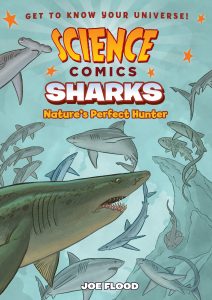
Welcome to the next stop on the Science Comics blog tour with First Second Books! First Second publishes some of my very favorite graphic novels and I cannot wait to check these nonfiction titles out. Look at all the great options:

Today I have a Q&A with Joe Flood, author of Science Comics: Dinosaurs and Science Comics: Sharks! Thanks to First Second for the interview.
 Why is science awesome?
Why is science awesome?
That is a really excellent question. The scientific process allows the universe to be a big as we imagine it to be. With each new discovery, science allows for new information to be tested and reassessed by scientists and added into the realm of human knowledge and understanding of our universe. The scientific process is unbiased and exacting, but always changing. If scientist A doesn’t produce the same data in their experiment as scientist B doing the same experiment, the idea is put aside. Perhaps something is changed about the idea or another idea added to it and suddenly the results are unanimous. Just like that another discovery is added to the ever growing pool of scientific knowledge. Ideas can be challenged, theories altered, but it cannot be done without evidence and the data to back it up. This is the solid foundation on which all science is based.
What makes comics a particularly amazing format to tell science nonfiction in?
It uses both words and pictures to tell a story that one or the other could not do alone. The story science has to tell can get very complicated. Concepts that can be very complex or hard to understand can be made clearer by using an image. Trying to describe how a shark’s jaw works (it has three separate moving parts) can be difficult, if you’re just using words. Show the reader an illustration and the whole thing becomes much clearer. The same can be done by labeling and describing a very complex picture. You might not have encountered the thing you are looking at, but a few descriptions make it easier to understand.
 How did you do research to make your book?
How did you do research to make your book?
Lots of reading. I read at least three books on sharks before I began writing my book on sharks. Also lots of visual reference, and usually I’d have to cross-reference my images with several sources. You’d be surprised how many pictures and videos of sharks are mislabeled, especially when you’re using the internet.
Tell us a little about the process of creating your book!
Some of it is done by hand and some on the computer. Both processes are vital to creating the images you see in the finished book. I start with an outline of ideas and then I start to sketch. Both writing and drawing is a crucial part of the initial creative process. Once I’m done sketching and I have plenty of notes and a basic outline, I start to thumbnail. This is a rough miniature version of the book. It maps out every page, panel and word balloon and allows both me and the editor a sense of what the finished book will look like. Then on larger sheets of heavy paper, called bristol, I pencil and then ink, using a brush and pen, the line art of the finished illustrations. The color and words are then added once the images have been scanned into the computer. It’s a lot of hard work and requires expertise in several different skills. It involves much more than just knowing how to draw.
What’s the coolest thing you learned while you were researching your book?
Osmoregulation. It’s what allows so many animals to live in salty sea water. It’s complicated and every type of sea creature has a different way of creating a balance between them and the salt water. In the most simple terms, salt draws water from cells, in order not to lose moisture, the cells must be a salty as their surroundings. A shark’s kidneys retain the highly salting uric acid in their blood. Basically sharks don’t urinate in order to maintain osmoregulation.
What’s the toughest part of turning science research into a comic?
Keeping the reader engaged. See the answer to the above question. This was perfect example of something that was  painstakingly researched and then cut from the book. Accurately describing how osmoregulation works requires previous knowledge. For one, being familiar with the terms “osmosis’ and “semipermeable membrane”. I’d have to lay a foundation of basic scientific concepts that would take several pages just to get to the conclusion; “Sharks don’t pee cuz they live in salt water”. An interesting piece of trivia, but meaningless without an understanding of the science that goes behind it. The basic mechanics of osmosis was not a tangent I thought my readers would be interested in. It would have been off topic and distracting.
painstakingly researched and then cut from the book. Accurately describing how osmoregulation works requires previous knowledge. For one, being familiar with the terms “osmosis’ and “semipermeable membrane”. I’d have to lay a foundation of basic scientific concepts that would take several pages just to get to the conclusion; “Sharks don’t pee cuz they live in salt water”. An interesting piece of trivia, but meaningless without an understanding of the science that goes behind it. The basic mechanics of osmosis was not a tangent I thought my readers would be interested in. It would have been off topic and distracting.
Have you always loved science since you were a kid?
Yes! Especially the natural sciences. Animals and plants have always fascinated me. How they’re put together and function. And how they relate to each other to create a diverse and complex web of life. Extinct animals, especially dinosaurs were alway the most fascinating. Animals that lived and died millions of years ago and yet we could learn so much about them from just studying their bones. It really ignited my imagination and the possibilities that were out there still yet to be discovered.
What do you recommend for kids who want to learn more about science and do more science?
Find resources in your area. There are always resources that go beyond your classroom. If there is an aspect of science that you find interesting in school, there is a world of resources available to you. If you are interested in nature, check your local park or nature preserve, there are usually guided nature tours available to the public. Most nature centers will have a schedule of events and activities for people of all ages. The library is also your best bet. There are films and documentaries available online, but proceed with caution, make sure what you’re watching is from a reliable source.
Check out the full tour schedule here.












Leave a Reply